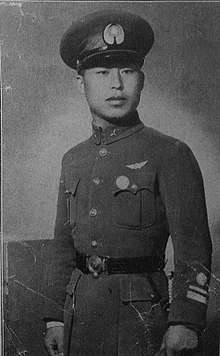Gao Zhihang
Gao Zhihang (Chinese: 高志航; Wade–Giles: Kao Chih-hang; 14 May 1907 – 21 November 1937) was a flying ace of the Republic of China in the Second Sino-Japanese War. On August 14, 1937, the 4th Air Force Group commanded by Gao shot down six Japanese planes over Jianqiao, while suffering zero losses. Subsequently, Gao became a Chinese war hero.
Gao Zhihang | |
|---|---|
 Gao Zhihang | |
| Born | 14 May 1907 Tonghua County, Liaoning, Qing China |
| Died | 21 November 1937 (aged 30) Zhoujiakou, Henan, Republic of China |
| Allegiance | |
| Service/ | |
| Years of service | 1920–38 |
| Rank | Colonel Major General (Posthumous) |
| Unit | Flying Eagle Squadron 4th Air Force Group |
| Commands held | 4th Air Force Group Pursuit Air Force |
| Battles/wars | Second Sino-Japanese War † |
| Awards | Order of the Sacred Tripod Three Star Medal |
Early life
Gao was born in Tonghua County of Liaoning Province into a Roman Catholic family on May 14, 1907. He was the eldest of six siblings.[1] Gao was admitted into the Education Class of the Northeast Army Officers as an artillery cadet. He was selected to receive flight training in France in the following year.[2] Gao returned to China in 1927 and was posted to the Flying Eagle Squadron of the Northeast Army under Marshal Zhang Zuolin and became a flight instructor in 1929.[1]
When the Japanese invaded Manchuria on 18 September 1931, he went south to join the Central Government and became an instructor in the Central Flying School near Hangchou. After returning from Italy after an inspection tour, he was made Deputy Chief of Instruction, and commander of the 4th Pursuit Group.[1]
Air battles
Battle of Shanghai
While Chinese intelligence reported a number of Japanese bombers having taken off from an airfield in Taiwan, crossing the Formosa Straits and were on a heading north in direction of Hangzhou in Zhejiang, the raid was detected by the Chinese air raid warning network.[1]
As soon as reports of the approach of the bombers at an altitude of four thousand meters came in, the pilots led by Colonel Gao ascended through the clouds, and found the enemy bombers in loose formation. Gao Zhihang pinpointed a Japanese G3M bomber and shot it down, sending it crashing in flames in the town of Banshan by the airfield. This was the first official victory for the Chinese Air Force against the invading Japanese air power. At least three more G3Ms were claimed by other pilots, some shared, including that of Major Art Chin. Colonel Gao's victory gave him a patriotic hero status in the news around the country; the 4th PG led by Gao Zhihang was officially named the "Zhihang Group".
Defense of Nanking
After almost two months of recovery from injuries sustained from gunfire in the attack against Japanese B2M attack planes from aircraft carrier Kaga over Hangzhou Bay in August, Colonel Gao sought to boost morale and improve the dogfighting performance of the Hawk IIIs. While on the shakedown of his airmen, he had his maintenance crews remove the bomb-racks, fuel tank cowlings, landing lighting equipment, etc. On October 12, 1937, he led an aggressive search-and-destroy mission consisting of six Hawk IIIs, two Boeing P-26/281s "Peashooters" and a Fiat CR.32 against any Japanese fighter aircraft approaching Nanking airspace. As they've expected, a group of Mitsubishi A5Ms was caught entering Nanking airspace, and in the ensuing fray, Major John Wong Pan-Yang, an Chinese-American volunteer pilot from Seattle, flying a P-26 "Peashooter", drew first blood shooting down the A5M piloted by PO1c Mazazumi Ino. Captain Liu Cuigang shot down another A5M and Colonel Gao scored a double-kill, shooting down two A5Ms including that of shotai leader WO Torakuma. This was a monumental moment of air-superiority exhibited by the Chinese pilots due to the great experience of Col Gao, Maj Wong and Capt Liu in particular, as they were outnumbered and yet so convincingly defeated the Japanese fighter group flying the far-more advanced Mitsubishis.[3]
Death
During October 1937, he was promoted to Commander of Pursuit of the Chinese Air Force, while remaining at the same time as commander of the 4th Group. By November 1937, Colonel Gao's 4th PG had flown to Lanzhou Donggang Airbase where they were re-equipped with the Polikarpov I-16 Type 5, and then leading the second group in their return-flight to Nanjing on 21 November to resume combat operations.[1][4][5]
While refuelling at Zhoujiakou Airfield, they were caught by some Japanese ten Mitsubishi G3M2s, who evidently were conducting a reconnaissance mission. The bombs were already falling when Kao ran to his I-16. The engine of the fighter wouldn't start and with the bombs falling closer, the ground crew, deciding that discretion was the better part of valour, left the aircraft to take cover. Chasing after them, Gao brought them back at the point of his service revolver to help him start the engine but lost his life when a bomb exploded alongside the aircraft.[1]
At the time of his death, Gao had claimed 4 biplane victories, these being claimed while flying the Curtiss Hawk III. According to official record of the Republic of China Air Force he is only credited with 3.5 victories and thus awarded the Three Star Medal.[1]
Legacy
Gao was promoted to Major General posthumously.[1] In 1940, the government announced August 14 would be Air Force Day to raise the morale of the Chinese populace.
He was the main character in the 1977 Taiwanese film Heroes of the Eastern Skies and the 2011 Chinese TV series Departed Heroes. He is also featured in the upcoming TV series Eastern Battlefield.
References
- "Colonel Kao Chi-Hang". Håkans aviation page.
- "Heroic figure: Gao Zhihang". PLA Daily. August 31, 2005. Archived from the original on 2011-05-16.
- http://surfcity.kund.dalnet.se/china_wong1.htm
- "拱星墩兰州城东曾经的商贸文化娱乐中心__中国甘肃网". gansu.gscn.com.cn.
- "兰州空战:中国空战史上最惨烈的一次大战(图)_资讯_凤凰网". news.ifeng.com.